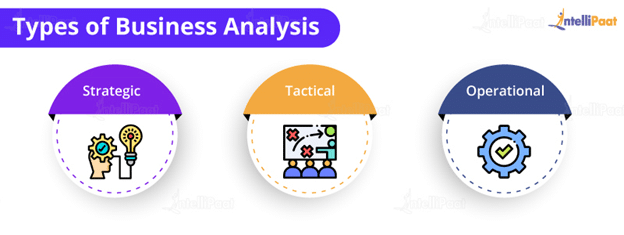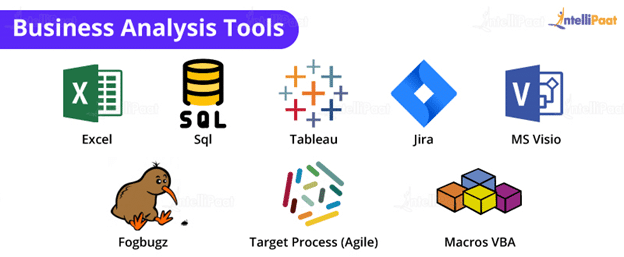Business Analysis Tutorial From Scratch
Following topics are covered in this business analysis tutorial
- What is Business Analysis?
- Why is Business Analysis Important?
- Types of Business Analysis
- Business Analysis Tools
- Who is a Business Analyst?
- What does a Business Analyst do?
- Business Analyst Responsibilities and Roles
- Skill Requirements for a Business Analyst
- Business Analyst career path
- Business Analyst basic concepts
- Conclusion
What is Business Analysis?
Business analysis is a system that identifies business needs and determines solutions to business problems. These solutions often include a software-systems development component, process improvements, organizational change, or strategic planning and policy development.
In retrospect, Business analysis involves solving issues in business. It deals with a lot of information that you have to analyze, compare and validate. It means communicating with all employees involved. In this Business Analysis Tutorial we will go in deep in defining business analysis, but first, let us discuss why is business analysis important?
Check out our free Business Analysis tutorial here!
Why is Business Analysis Important?
Business Analysis plays a vital role in every organization. Today analyzing business requirements, creating documentation, identifying areas for improvement, and organizational change. It is important in strategic planning and developing various policies that enhance an organization.
An organization uses business analysis to achieve its goals by identifying and implementing specific changes. It sometimes involves changing various policies and processes within an organization to compete better in the market.
One of the key roles of a business analyst is to facilitate communication by acting as a bridge between stakeholders and the development team. Business analysis is a way to transform business requirements from project stakeholders into simple documents so they can be understood by developers.
It is helpful in Project Implementation and Testing because the development phase of the project includes preparing and implementing the software solution needed to fulfill business requirements in the form of a working product.
The business analysis also helps in understanding the impact of political, environmental, social, and technological factors on the strategy of an organization.
Now, moving ahead in this business analysis tutorial, let us have a look at business analysis types.
Types of business analysis
There are 3 types of Business analysis which we can categorize into −

- Strategic Analysis − Strategic business analysis deals with work in the pre-project phase. It involves a method or process of identifying business problems, finding business strategies, goals, and objectives to help the top management. It gives management information reporting to facilitate an effective decision-making process.
- Tactical Analysis − This involves knowledge of specific business analysis techniques to apply when it is required in the appropriate project.
- Operational Analysis − In this type of business analysis, we are focused on the business aspect by using Information Technology.
Here, we study operational systems with the aim of identifying opportunities for business improvement.
Business Analysis Tools
- Excel:- Excel sheet is one of the most important business analysis tools that is used. It is very useful through the process of business analysis.
- SQL:- SQL is a scripting language designed for managing data in relational database management systems. This tool allows business analysts to perform a certain amount of data analysis and testing on their own while performing business analysis.
- Tableau:- Tableau is a great visualization tool and plays a great part in a business analysis process. It is also a great tool for descriptive analysis. Visualization of the data is the communicative platform that lets the company understand the suitable course of action.
- JIRA:- JIRA is a task management and business analysis tool which helps every business employee across the company to plan, track, and report on work. It is possible to customize them as per specific business needs with the help of this tool.
- Fogbugz:- FogBugz is a project management and issue tracking software that helps in saving time on managing and more on building software. It is designed to help plan, track, and release software. FogBugz is designed for agile-first, focusing on a simple lightweight workflow that seamlessly integrates with your development process.
- Target Process (Agile):-Targetprocess is a visual platform to help in adopting and scaling agile across your enterprise. It is possible to use SAFe, LeSS, or implement a business-owned framework to achieve business agility and see the value flow through the entire organization.
- Macros VBA:- VBA is a programming language for MS Office Application, which stands for Visual Basic for Applications and it automates the task being done manually and repeatedly.

Who is a Business Analyst?
Business analysts decrease the gap between Information Technology and the business using data analytics to assess processes and make data-driven recommendations to executives and stakeholders.
Business analysts are responsible for understanding business requirements, laying out plans for the company, and developing actionable insights. This role combines skills like analytics and business knowledge. Business analysts look into client and business requirements and communicate with clients to understand their business perspectives.
Also, have a look at our Business analyst course in Chennai to learn business analysis from experts!
What does a Business Analyst do?
Business analysts are involved in problem-solving techniques. They employ statistical and interpersonal skills in a business setting. They use SQL and visualization tools like R, Tableau, and Excel for dealing with data.
They look into the ever-changing needs of any business and assist in the implementation of those changes. They communicate between different departments in an organization to execute any business plan. Business analytics is better suited for professionals with experience in business development, project management, and technology. We will learn how all these are done by business analysts in this business analysis tutorial.
Business Analyst Responsibilities and Roles
Given below is a list of roles and responsibilities of a Business Analyst:-
- They engage with existing and prospective customers and help them understand products and solutions to meet their business requirements.
- They ensure consistent growth in awareness, adoption, and usage of products.
- They understand the client’s business objectives and application needs.
- They design the solution that best meets the client’s requirements
- They promote products and solutions using presentations, demos, and effective documentation
- They create documentary artifacts like business cases, usage scenarios, FAQs, and meeting notes.
- They lead or work with other customer success teams to ensure the successful completion of project milestones for production.
- They lead client training sessions and support clients and play a key role in promoting solution adoption and usage.
- They provide end-user feedback to the product team
Enroll in our Business Analyst course to get certified by experts!
Skill Requirements for a Business Analyst
The aim is to understand what are the skills required for becoming a skilled Business Analyst. Given below is a list of Business Analyst skills:-
- A technical degree for example:- Engineering or MC, or business degree for example- MBA or BBA from a reputed institute with a minimum of 4-5 years of experience in software or consulting industry
- Certification in the knowledge areas related to information security, business – process management, or IT infrastructure
- Knowledge of information security procedures and practices
- Have experience of working for leading technology consulting companies
- Enterprise-level business project experience with strong process analysis, design, delivery, and documentation skills
- Skills to manage, plan and organize multiple projects
- Presentation skills to demonstrate solution concepts
- Ability to influence and build effective customer relationships
- Experienced with general consultation skills that include team facilitation, business case development, and strong business analysis skills
- Systems implementation skills: conceptual and detailed design, configuration, testing, training, change management, and support

Business Analyst career path
Moving ahead in this business analysis tutorial, let us discuss the ideal career path of a business analyst. To become a business analyst, a bachelor’s degree in management is required.
The candidate is required to have some experience in business administration and needs to know various concepts that will be used in their business analyst roles.
The career path for a business analyst is not a straight line, and the graph depends on where the starting point is in terms of business analyst roles. The traditional career growth is moving up to higher-level roles, from business analyst to senior business analyst to business architect.
Similarly, in an agile environment, you may go from business analyst to product owner and can change branches to managing a team and then PMO director. From there, it is possible to become vice president, senior vice president, and CIO. Each of these stages requires new skills and the ability to expand your influence.
There might be a need to shift between types of analysis to benefit the organization. A Business Systems Analyst may become a senior analyst and then a technology architect or an enterprise architect. From Project Manager, you may go to senior project manager, to program manager, to business owner and climb up to the business owner role.
There is also a possibility of changing roles in the same position from a project manager, to the product owner, and finally to a user experience designer. Skill sets can be particularly improved by learning different skills from all these roles.
Preparing for job interviews? Have a look at our blog on business analyst interview questions to excel your hiring journey!
Business Analyst basic concepts
The following is the list of core concepts of business analysis:-
- Change:- Change is an action taken to transform in response to a need. It is required to be performed to improve the performance of an enterprise. These improvements are deliberate & controlled through business analysis activities.
- Need:- Need is a request or an opportunity that is required to be addressed. They can cause changes by motivating stakeholders to act in response to those needs. Changes can also cause needs by degrading or enhancing the value of the solution.
- Solution:- Solution is a way of satisfying one or more needs in a context. A solution satisfies a need by resolving a problem faced by stakeholders or enabling stakeholders to take advantage of opportunities to the benefit of the business.
- Stakeholder:- Stakeholders are individuals who are related to the above-mentioned change, need, or solution. They are often defined in terms of interest in, impact on & influence over change. They get grouped based on their relationship to the needs, changes, and solutions.
- Value:- Value is the importance of something to a stakeholder within a context. There are two types of value, tangible & intangible.
- Tangible value is something that is measurable in terms of gains or profit. They provide a measured value.
- Intangible gains are an indirect benefit of the solution. They are strategic in nature and have a positive impact on the company’s brand image & employee morale.
- Context:- Context deals with the circumstances of the change that occurs. It helps in understanding how circumstances influence or get influenced by the context.
Context explains and defines the environment of change as all changes occur within a context. These changes may include behavior, beliefs, competitors, demographics, goals, government, losses, sales, seasons, technology, weather, and any other element meeting the definition.
These core concepts have characteristics that need to be remembered. Firstly, no concept is bigger or better than other concepts and we cannot apply them in isolation. Secondly, these concepts are vital for Business Analysis and you cannot perform BA without applying them. And lastly, each core concept is defined by other 5 concepts & cannot be understood or explained in isolation, therefore, they should be applied together in the field of business analysis.
These core concepts can be used by business analysts to consider the quality and completeness of the business analysis work being done. In the business analysis process, these core concepts are always required to be addressed.
Conclusion
In this Business Analysis Tutorial Blog, we defined what business analysis is and what its type is. We also discussed who the business analyst is, their roles and responsibilities. We then went through tutorials and finally described career path options for becoming a business analyst. I hope this blog gained you some insights and taught you.
If you have any questions, ask them out in our community right away!
The post Business Analysis Tutorial From Scratch appeared first on Intellipaat Blog.
Blog: Intellipaat - Blog
Leave a Comment
You must be logged in to post a comment.









